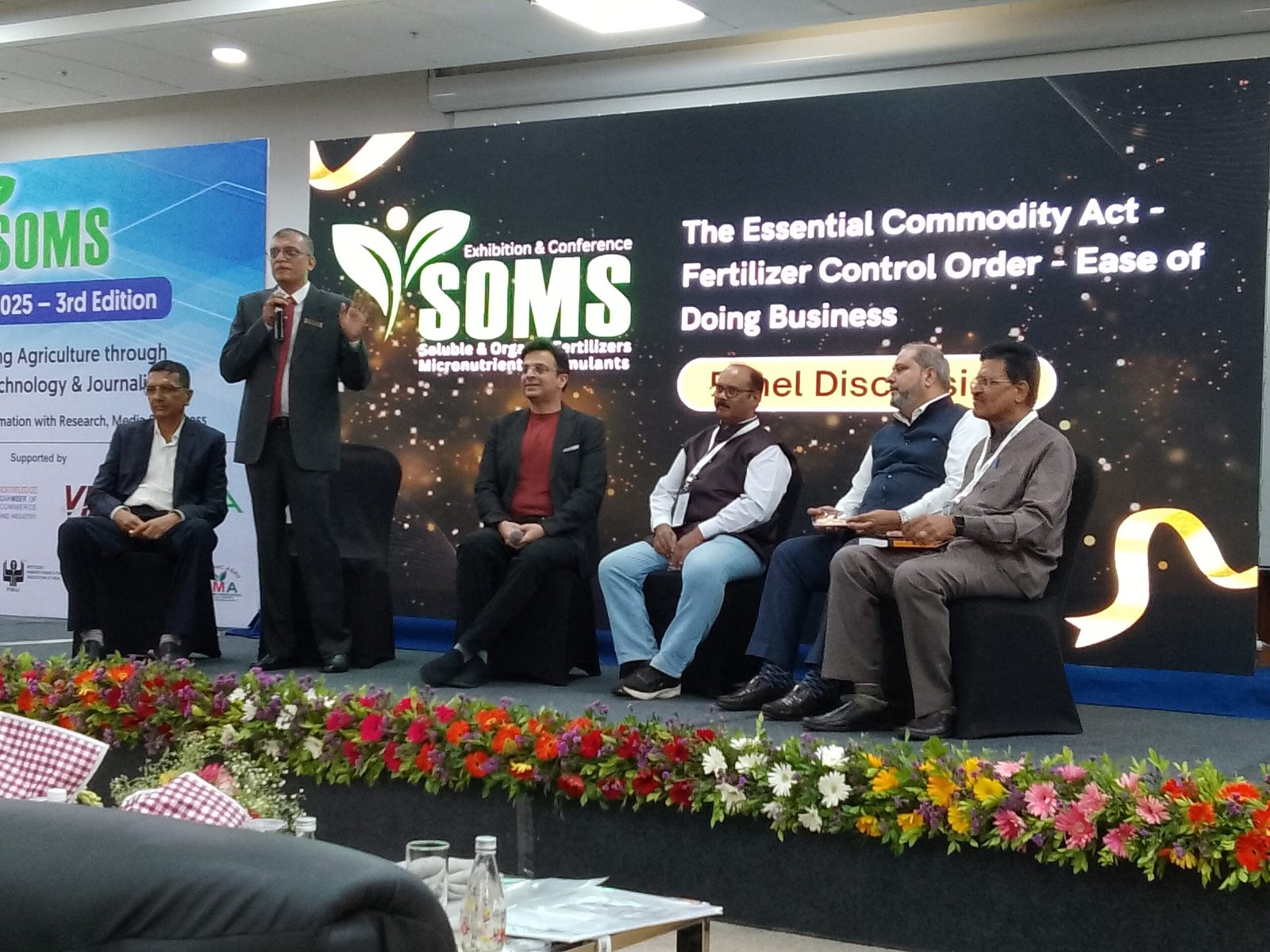Friday, 28 November 2025

India’s fertiliser regulations, conceived in an era of scarcity, have admirably served their foundational purpose—but now appear increasingly incongruous with contemporary realities. The Fertiliser Control Order, while historically significant, has evolved into a complex web of compliance that often impedes innovation and burdens genuine enterprise. In an age of seamless digital trade, robust domestic manufacturing, and precision agriculture, such regulatory vestiges merit thoughtful re-examination. A shift toward a unified, centralised licensing regime could retain necessary safeguards while easing access, encouraging innovation, and reducing costs for farmers. Reform, in this context, is not a repudiation of legacy, but a prudent recalibration for a more agile and aspirational agricultural economy.
In the ever-evolving theatre of Indian agriculture, few regulatory legacies weigh as heavily—and as paradoxically—as the Fertiliser Control Order (FCO), instituted under the Essential Commodities Act (ECA). Once indispensable to national food security, this mid-20th-century framework is now misaligned with the needs of a 21st-century agri-economy defined by digital infrastructure, entrepreneurial dynamism, and climate-responsive innovation. What was once a pillar of protection has, over time, become a brake on progress.
Framed in the 1950s, the FCO was a policy born out of necessity. Its objectives—ensuring fertiliser quality, curbing black marketing, and supporting farm productivity—were foundational during India’s era of acute food insecurity. In a nation struggling to grow enough to feed itself, such controls were not only valid but vital.
From Safeguard to Straightjacket
Today, however, India’s agricultural landscape has changed fundamentally. Food production is in surplus. Fertiliser supply chains are resilient and well-established. Domestic manufacturers have matured, and e-commerce platforms along with GST-enabled logistics have made interstate movement seamless. The regulatory impulse to ration and restrict no longer reflects the structural realities on the ground.
Yet, fertilisers continue to be governed as if India remains in a perpetual state of scarcity. This dissonance between policy and progress has tangible consequences—particularly for the country’s small enterprises and its millions of farmers.
Where Policy Intent Collides with Operational Reality
To bring a single fertiliser product to the national market, a company must still secure a manufacturing licence, register each formulation individually, and obtain separate sale permissions in every state where it hopes to operate. Even after clearing central approvals, firms must navigate duplicative paperwork, endure repeated inspections, and establish physical depots in every state—despite the harmonisation GST was designed to bring.
“Specialty agrochemical entrepreneurs are not mere manufacturers—they are consultants in the truest sense, walking with the farmer every day, field by field. Yet, we operate in the most inspected industry in India. How do we expect to compete with China when our innovators are entangled in compliance instead of empowered by it? The law may promise freedom, but its implementation must reflect that spirit. Agriculture begins with inputs, and yet agri-inputs find no mention in flagship schemes like AIF. We need a clear distinction between substandard and spurious products, digital tools that serve—not delay—MSMEs, and above all, the courage to let research fail a thousand times to succeed once. If China took 25 years, India can do it in five—but only if we shift into top gear and clear the road ahead ” — Rajib Chakraborty, National President at SFIA – Soluble Fertilizer Industry Association, India
For MSMEs, this creates a daunting barrier to entry. The burden is not just administrative; it is financial. Compliance costs, inflated by procedural delays and redundant infrastructure, are estimated to raise product prices by 8 to 15 per cent. For manufacturers, these costs erode competitiveness. For farmers, they represent yet another input expense in an already volatile economy.
Compounding this is the issue of enforcement. Product testing is often conducted in government laboratories that lack accreditation from the National Accreditation Board for Testing and Calibration Laboratories (NABL), leading to inconsistent results. Inspectors continue to wield broad powers, and even minor clerical or labelling deviations can result in criminal prosecution. It is a system that too often penalises procedural missteps while leaving little room for good-faith error.
While compliance challenges are most visible in boardrooms and manufacturing units, their impact is most acutely felt in the fields. When regulatory bottlenecks delay the launch of improved fertiliser products—such as micronutrients, water-soluble blends, and climate-adaptive formulations—it is the farmer who is deprived of timely access to better solutions.
In an era marked by erratic rainfall, depleted soils, and shifting crop calendars, these next-generation inputs are not luxuries; they are essential tools of resilience. A framework that inhibits their availability inadvertently hampers the very goals it seeks to uphold: higher productivity, better income for farmers, and long-term food security.
At the heart of the issue lies the FCO’s continued association with the Essential Commodities Act. Fertilisers, though undeniably vital, no longer warrant the same emergency-driven controls that shaped this classification. The agricultural market has matured, supply remains largely uninterrupted, and the logic of market pricing prevails for most non-subsidised fertilisers.
” The classification of fertilisers as ‘essential commodities’ under the EC Act may have served its purpose in an era of scarcity, but in today’s context, it perpetuates regulatory inefficiencies that no longer align with ground realities. There are no shortages. Food security is assured. Markets are mature. Also, GST has already shown us what a unified national framework can achieve. Just as GST introduced one nation, one tax, it’s time for fertilisers to adopt One Nation, One Licence. A single, digital, pan-India registration can replace the obsolete patchwork of state-wise approvals—ushering in transparency, traceability, and real ease of doing business. The fragmented regime we operate under today adds 8 to 15 per cent in avoidable costs that farmers silently bear. Rationalising this isn’t just smart economics—it’s agricultural justice ” — Dr Rahul Mirchandani, President, Indian Micro-Fertilizer Manufacturers Association (IMMA)
It is time, therefore, to consider a bifurcated approach. Subsidised fertilisers such as urea, where government spending is significant and price controls remain necessary, can justifiably remain under stricter oversight. However, for customised and specialty fertilisers that fall outside the subsidy regime, a more agile and market-aligned regulatory architecture is warranted—one that upholds standards without stifling innovation.
At the core of such reform is a compelling proposition: a unified, pan-India licensing regime for fertilisers. A single national licence, issued through a transparent, digital portal, could replace the existing patchwork of state-level permissions. This would eliminate the need for multiple registrations of the same product and reduce logistical redundancies like mandatory depots in every geography.
“In recent years, we’ve seen a wave of agri-startups bringing fresh ideas into the input space—but very few step into fertiliser manufacturing. The regulatory terrain is dense, and the recognition for agro-entrepreneurs remains limited. While agriculture is often viewed as a state subject, fertiliser regulation under the FCO is centrally governed, making alignment both necessary and possible. The time is ripe to bring all stakeholders together—startups, policymakers, scientists—through a national Hackathon that doesn’t just ideate, but culminates in a policy seminar with implementable outcomes. Innovation needs a platform. Reform needs a process ”—- Dr Suhas Buddhe , Past Vice President, Vidarbha Industries Association
Product validation, instead of relying on opaque pre-approval procedures, could be managed through truthful labelling and third-party testing in NABL-accredited laboratories. Regulatory oversight would shift from preventive restriction to post-market surveillance—targeting fraudulent actors without unduly burdening the compliant majority. Minor infractions could be decriminalised and addressed through graded penalties, while manufacturing licences could be made valid for longer durations to reduce administrative fatigue.
Such a shift would do more than ease compliance. It would create a climate of trust and accountability, enabling India’s fertiliser sector—especially its MSMEs and startups—to develop, innovate, and compete both domestically and globally. It would also align the fertiliser policy ecosystem with broader national initiatives such as Make in India and Atmanirbhar Bharat.
To be clear, this is not an argument for regulatory abdication. The quality of agricultural inputs must be maintained. Farmer safety must be protected. However, these goals can be achieved through smart, targeted oversight—without encumbering the sector with rules that no longer reflect the present, let alone the future.

“For a state as large and agriculturally diverse as Maharashtra, introducing a division-wise licensing mechanism for fertilisers can make a tangible difference. It would ease operational costs for agri-entrepreneurs, particularly MSMEs, who currently struggle with the financial and logistical burden of state-wide licensing requirements. At the same time, regulatory oversight can still be effectively maintained at the divisional level. This is not about dilution of standards—it’s about smart simplification. A division-wise framework offers a practical middle ground: cost-effective for industry, manageable for administrators, and ultimately beneficial for farmers. When we streamline regulation, we create an ecosystem that rewards compliance, encourages investment, and fosters innovation where it’s needed most ” — Vijay Thakur, President, Organic Agro Manufacturers Association
India has successfully undertaken bold reforms in other domains—taxation, insolvency, digital governance. It has the institutional maturity and policy muscle to now extend that vision to the fertiliser sector. Reforming the FCO is not a matter of ideology; it is a question of economic alignment and agricultural relevance.
The future of Indian agriculture will depend not only on what farmers grow, but on what systems enable them to grow it. Fertilisers are no longer just inputs; they are vehicles of innovation, resilience, and sustainability. If we continue to regulate them through a lens of distrust and restriction, we risk stalling the very progress we seek.
A modern, harmonised licensing regime—One Nation, One Licence—is a logical, pragmatic next step. It would honour the spirit of the original FCO while freeing the sector from its most outdated constraints.
In doing so, it would allow India’s farmers, agri-innovators, and entrepreneurs to thrive—not in spite of regulation, but because of its intelligent design.
———– Suchetana Choudhury (suchetana.choudhuri@agrospectrumindia.com)